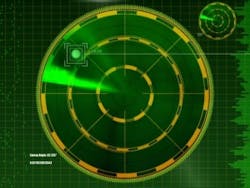DARPA to integrate D/A converters and amplifiers to enhance power efficiency for EW, sensors, and communications
ARLINGTON, Va., 16 Jan. 2011.RF and microwave experts at the U.S. Defense Advanced Research Projects Agency (DARPA) in Arlington, Va., are asking industry to find ways of combining digital-to-analog (D/A) converter and high-power amplifier technology in one device to create a new frontier of power efficiency for electronic warfare, radar, and military communications systems.
DARPA released a broad agency announcement (DARPA-BAA-11-12) for the Direct Digital to High Power Analog Conversion Technology (PowerDAC) program to combine D/A converter and high-power amplification into one component to achieve simultaneous high power, large bandwidth, high efficiency, and high linearity at RF and microwave frequencies. The idea is to create new transmitter architectures that will be scalable in power, operational frequency, and bandwidth, based on many fast silicon or silicon-germanium devices.
The DARPA Microsystems Technology Office (MTO) is soliciting innovative research proposals in the area of Direct Digital to High Power Analog Conversion (PowerDAC) Technology. This will enable the combining of digital to analog conversion and high power amplification into a single component technology realizing revolutionary advantages. These advantages include dramatically advancing the state of art in the ability to simultaneously achieve high power, large bandwidth, high efficiency and high linearity at RF and microwave frequencies.
Emerging battlefields have dense and complex electromagnetic environments that can make managing electronic jamming, active sensors, and communications difficult, DARPA officials say. The PowerDAC program seeks to develop new technologies that will improve spectral purity. and replace current state-of-the-art D/A converters, high-power amplifiers, and related components to improve system performance and reduce electronic fratricide, while reducing power consumption and system size and weight.
Although some of the latest compound semiconductor mixed-signal technologies have demonstrated output powers exceeding 10 Watts in monolithic gallium nitride power amplifiers over 2 to 19 GHz with efficiencies approaching 25 percent, emerging military applications require noise-power ratio (NPR) levels that exceed the capability of state-of-the-art high power amplifiers, DARPA officials explain.
The DARPA PowerDAC project seeks to develop integrated circuits and microsystem architectures capable of producing high-NPR signals efficiently over multi-gigahertz bandwidth at very high power. DARPA seeks industry proposals for heterogeneous or compact multichip module PowerDAC technologies with direct transition paths to military systems.
DARPA would like to develop high power, high efficiency, linear, broadband integrated circuit PowerDAC technology; and to demonstrate prototype technology in military systems such as electronic warfare, radar, and communications.
Companies interested should respond no later than 28 Feb. 2011 to DARPA's Daniel Purdy by e-mail at [email protected], or by post at DARPA/MTO, ATTN: DARPA-BAA-11-12, 3701 North Fairfax Dr., Arlington, VA 22203-1714. A proposer's industry day will be 25 Jan. 2011 in the Arlington, Va., area.
For questions or concerns, contact Purdy by e-mail at [email protected], or by phone at 703-248-8070. More information is online at http://www.fbodaily.com/archive/2011/01-January/15-Jan-2011/FBO-02359608.htm.

